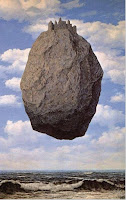Quarterly 3, 2025
Top Ten Strange & Bizarre Paintings
While browsing through the wonderful website of Daily Art Magazine I came across their piece on the Top Ten Strange and Bizarre Paintings. It's well worth your time to examine.
At least half of these I was familiar with from my time as an A.P. Art History instructor, but the other half were new to me and really enjoyed being introduced to them.
I was happy to see they began with Hieronymus Bosch's famous triptych The Garden of Earthly Delights (ca. 1480-1505). While traveling in Italy in 2001, I came across a delightful collection of reproductions of characters found in this masterpiece.
I purchased "the egg man" - and he has become quite the conversation piece sitting on one of my bookshelves.
Enjoy the other selections at
https://www.dailyartmagazine.com/top-10-bizarre-paintings/
_____________________
Quarterly 1, 2024

"The only thing of worth
that I found in Houston
was a Magritte at the Menil."
-- Terry.
I've spent a fair amount of time in Houston, having lived close by while pastoring a church in Crosby for two years and, five years later, making the mistake of moving there. The realization I'd made a horrible error in judgment came two months after setting up house in the Heights neighborhood.
That month of realization was June, the gauge read 80, and I was drenched in sweat. Among the horrors I discovered in Houston then were its humidity, frequent flooded roadways, irritating sectioned-concrete roadways, congested roadways, unzoned and filthy inner-city roadways, and -- did I mention the humidity? The only thing forcing me to remain a full year was a lease I had signed. Once done with that concrete jungle, I high-tailed it back to the greenbelt, Hippie Hollow and Barton Springs where the enveloping cloud I existed in was sweet dope and not the wafting benzene of Stink-a-dena.
Of course I did enjoy the Houston Arts scene - plays at the Alley, HGO at the Wortham, traveling musicals, and quality exhibitions at fine museums such as the Menil. I must have visited The Menil Collection down in the Montrose /Westheimer area at least 6 or 7 times while in Houston, often with my visiting friends or family in tow. Without fail I would lead them to my favorite work and, long after they had ventured on to see more of the remarkable collection of John and Dominique de Menil, I would find myself still standing before this single artwork mesmerized.
 |
| Rene Magritte's Golconda; 1953 [Menil Collection] |
Golconda was a ruined city in the state of Andhra Pradesh, India, near Hyderabad and from the mid-14th until the 17th century it was the center of the region's legendary diamond industry -- where perhaps thousands of nameless men died.
In this, my favorite painting of his Golconda, Magritte seems to me to be commenting on the alienating condition of life in modern cities or even the suburbs with their stacks of cookie cutter houses and how mass society tends to anonymize people. It symbolizes how people can lose their individuality as they become part of a mass consumerism culture, thus becoming isolated.
My inner struggles are presented here with such clarity in two ways:
First, my lifelong resistance to being a clone in a community of clones where all the men folk are supposed to have the same haircut, wear a cap or cowboy hat and wear it the same way, have identical interests and never deviate from that script... Magritte presents that sad, tragic, and boring uniformity of enforced male norms.
Second, my lifelong inner anxieties are presented here of life lived without relevance, having contributed nothing, ending in isolation and anonymity.
And so it was that the Menil in Houston introduced me to Magritte and I became a surrealist junkie - reading up on the works of others like Dali, Man Ray, Max Ernst, and the enthralling Andre Breton. But it would be Magritte's subject matter and manner of depiction that most fascinated me.
I mean, who could not be drawn into the mysteries (and we all know how much I love mysteries) presented in these works of Magritte:
The Lovers (1928)
On February 24, 1912, Magritte's mother committed suicide by drowning herself. Apparently it was not her first suicide attempt. Her body was not discovered until March 12.
According to a legend, 13-year-old Magritte was present when her body was retrieved from the water, and her dress was covering her face. This image has been suggested as the source of several of Magritte's paintings in 1927–1928 of people with cloth obscuring their faces, including Les Amants (The Lovers).
The Castle of the Pyrenees (1959)
One of Magritte's best known and most-reproduced images, this painting "embodies the artist's typical disturbing juxtaposition of familiar objects, combined with captivating poetry and mystery."
It was commissioned by the artist's long time friend, the international lawyer, poet, and author Harry Torczyner. Letters between the two reveal how much Torczyner contributed to the manner in which the subject matter was presented.
Mysteries of the Horizon (1955),
Had Magritte already envisioned the existence of parallel universes?
Because I think that is what is so cool about this painting - the same man captured in a moment in time but in different universes. Though they appear to be sharing the same space each one also seems to exist in a separate reality.
or The Menaced Assassin (1927)
Actually, the painting is derived from a scene in Louis Feuillade's Fantomas film of 1912. It depicts two figures concealed by the doorway, armed with strange weapons, watching the "murderer," who is dressed in a business suit.
translation of waking life,
waking life is also a translation
of the dream."
____
Quarterly 4, 2023
 |
| "Autumn Harvest," Norman Rockwell; 1963 - the year I was born! |
 |
| Norman Rockwell in his studio b. 1894 – d. 1978 |
 Rockwell possessed a distinct ability to create works of art that evoke a strong emotional response. Many of the emotions drawn from the viewer are memories of formative events from their own lives, nostalgia toward a time long gone, or a feeling of Americans collectively united through war-time patriotism.
Rockwell possessed a distinct ability to create works of art that evoke a strong emotional response. Many of the emotions drawn from the viewer are memories of formative events from their own lives, nostalgia toward a time long gone, or a feeling of Americans collectively united through war-time patriotism.Rockwell was a prolific artist, producing more than 4,000 original works in his lifetime. Most of his surviving works are in public collections.
Rockwell was also commissioned to illustrate more than 40 books, including Tom Sawyer [right] and Huckleberry Finn as well as painting the portraits for Presidents Eisenhower, Kennedy, and Johnson.
Here are a few of my favorite Rockwell's, and don't miss at bottom of page the interesting graphic about Rockwell from the Spring 2023 issue of Lapham's Quarterly.
 |
| "Little Girl Observing Lovers On A Train" By Norman Rockwell Saturday Evening Post, 1944. Fair use |
 |
| "Rosie the Riveter," 1943 By Norman Rockwell Curtis Publishing, Fair use |
 |
| "Triple Self-Portrait" By Norman Rockwell Saturday Evening Post, Fair use |
 |
| "Breaking Home Ties," 1954 By Norman Rockwell NYTimes, Fair use |
"Refugee Thanksgiving"
by Norman Rockwell
November 27, 1943
 |
____________________________
I loved this recent graphic about Rockwell that I came across in the Spring issue of Lapham's Quarterly.
In his 1941 annual message to Congress, Franklin D. Roosevelt spoke of a future founded on “four essential human freedoms”: freedom of speech, freedom of worship, freedom from want, and freedom from fear.
A year later, after the United States entered World War II,
artist Norman Rockwell began to translate the Four Freedoms into “simple, everyday scenes” for The Saturday Evening Post, which published them in February and March 1943. Sales of posters of the paintings raised $132 million in war bonds.
freedom of speech
(1) Rockwell often said that the inspiration for the series was a town meeting in Arlington, Vermont, where he had witnessed a resident protesting a popular plan to build a new school.
(2) Rockwell biographer Deborah Solomon found this scene unconvincing: in addition to the “near absence of women,” she notes, “it seems unlikely that the established banker types would be trying to glean wisdom from an ordinary worker.”
(3) When the painting appeared in The Saturday Evening Post in February 1943, it was accompanied by a short story by Booth Tarkington in which the young Adolf Hitler and Benito Mussolini meet in 1912 and discuss how dictators must destroy freedom of speech.
freedom from fear
(1) Rockwell received more than sixty thousand letters about the Four Freedoms series. One, from the Pioneer Suspender Company, noted that “the father in Freedom from Fear was wearing a pair of suspenders from Pioneer. He had damn good reason to be free from fear…as long as his pants were being held up by Pioneer.”
(2) “I really believed that the war against Hitler would bring the Four Freedoms to everyone,” Rockwell said in 1976, “but I couldn’t paint that today. I just don’t believe in it. I was doing this best-possible-world, Santa-down-the-chimney, lovely-kids-adoring-their-kindly-grandpa sort of thing. And I liked it, but now I’m sick of it.”
(3) Rockwell later said he never liked this painting or Freedom from Fear because the two had no “wallop.”

freedom from want
(1) “Freedom from Want was not very popular overseas,” Rockwell recalled in his 1960 memoir. “The Europeans sort of resented it because it wasn’t freedom from want, it was overabundance, the table was so loaded down with food.”
(2) The Saturday Evening Post asked the Filipino American novelist and poet Carlos Bulosan to write a text to accompany this painting. He described “forces which have been trying to falsify American history” and “drive many Americans to a corner of compromise with those who would distort the ideals of men that died for freedom.”
freedom of worship
(1) Rockwell grew so frustrated with his first version of the painting, which depicted men of various faiths “laughing and getting on well together” in a barbershop, that he scrapped it and started over.
(2) Rose Hoyt, the model for the woman holding rosary beads, was an Episcopalian. Rockwell asked her, “Would you be a Catholic for today?”
(3) In 2018 a group of photographers exhibited updated versions of Rockwell’s Four Freedoms, with a cast of models more diverse than Rockwell’s neighbors. “America didn’t look like that then,” artist Hank Willis Thomas said in an interview. “It definitely doesn’t look like that now.”
 |
| Rockwell's Studio in Stockbridge, Massachusetts By User:Rmrfstar - Own work, CC BY 2.5 |
 |
| Rockwell died on November 8, 1978, of ephysema at age 84 in his Stockbridge home. First Lady Rosalynn Carter attended his funeral. |
Terry’s “Good Living” Guide:
Avoid the 3 PsBsSs
Processed Foods, Phthalates, Plastics;
Beef, Butter, Breads;
you’ll be feeling better in no time!
Avoid the 3 F’s
misinformation, fear, anger and hate!


















No comments:
Post a Comment